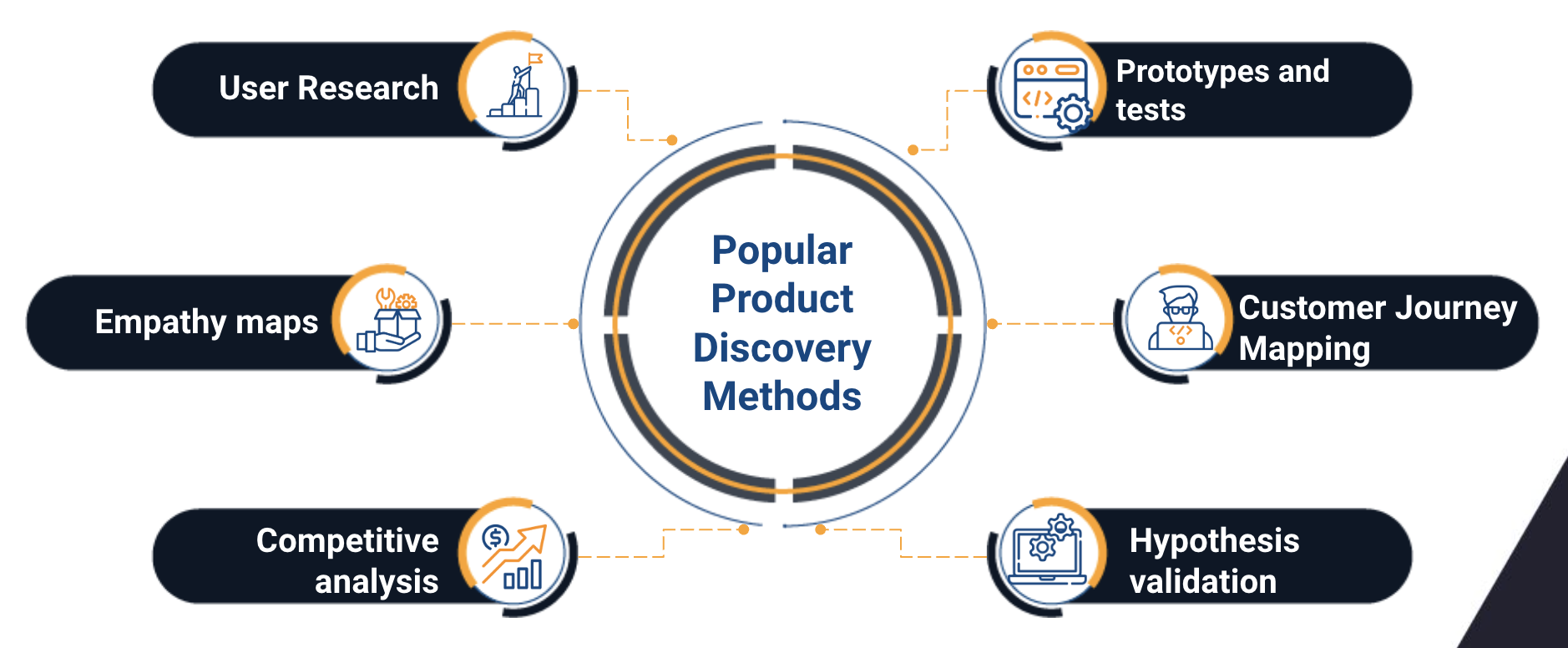
Popular Product Discovery Methods
November 06, 2024
Table of contents
Quick Access

In the world of product development, the product discovery stage has become essential to the success of any initiative. This process allows companies to understand the needs of their users and tailor their products according to the specific problems and desires of the target market.
Throughout this article, we'll delve into some of the most popular product discovery methods and offer specific examples of how this approach benefits five key industries.

What is Product Discovery?
Product discovery is a process that helps companies figure out what product to develop or how to improve an existing one. This initial phase of any development cycle focuses on understanding customer needs, identifying problems to solve, and reducing risks. Development teams, along with UX and business experts, explore hypotheses to ensure the final product is functional and appealing to users.
Popular Product Discovery Methods
There are multiple approaches to conducting product discovery, each with its own benefits. Here are some of the most commonly used methods in this critical phase:
1. User Research
This method focuses on thoroughly understanding users' needs, preferences, and problems through interviews, surveys, and field studies. It is key to gaining direct insights from users and allows teams to empathize with them.
2. Empathy Maps
An empathy map helps visualize what users think, feel, and how they interact with the product. This method is useful for digging deeper into user motivations and emotions and building a product that resonates with their experience.
3. Competitor Analysis
Analyzing what the competition is doing allows you to identify opportunities to differentiate yourself and develop unique features. Competitive analysis helps you understand the market and adjust the product according to demand and supply.

4. Prototyping and usability testing
Creating early prototypes and conducting usability tests allows you to validate ideas before moving forward in development. With these prototypes, users can interact with a preliminary version, and the team gets real-time feedback to fine-tune the product.
5. Customer Journey Mapping
This method focuses on mapping the entire customer experience to identify pain points and opportunities for improvement. Understanding the customer journey allows you to tailor the product to deliver greater value at each touchpoint.
6. Experimentation and hypothesis validation
Testing and validating hypotheses helps reduce risks and ensure that the team's ideas are useful to users. This process can include A/B testing or controlled releases to measure impact and continually improve.
Examples of Product Discovery in Different Industries
Each industry has specific needs and challenges. Below, we explore how product discovery can benefit five different sectors.
Healthcare
In the healthcare sector, product discovery is critical to ensuring that technology solutions truly address the needs of physicians and patients. For example, during the product discovery process for a telemedicine app, the development team could use user research to identify patients' top concerns, such as ease of use and confidentiality of their data. By better understanding these concerns, the app can be designed to be intuitive and secure, increasing trust and usage.
Finance
For the financial industry, security and reliability are critical. A well-executed product discovery process could include competitor analysis to understand which digital banking platforms are popular and why. By identifying features such as two-factor authentication and a simplified interface, the team can design a financial app that stands out in the market and is easy to use and trustworthy for its users.
Retail
In the retail sector, where competition is fierce, product discovery helps companies design products that truly appeal to consumers. For an e-commerce platform, customer journey mapping might reveal that users abandon their carts due to a complicated checkout experience. With this information, the team can simplify the checkout process, resulting in a higher conversion rate and customer satisfaction.

Education
The education industry needs products that are accessible, intuitive, and effective for students and educators. For an online learning platform, using prototypes and usability testing in the product discovery process can reveal specific difficulties in site navigation. From these results, the team could simplify the platform design to improve the learning experience and user retention.
Manufacturing
In the manufacturing sector, where production processes are complex, product discovery is key to developing tools that optimize operations. One example is an application for machine monitoring.
Through empathy mapping and interviews with operators, the team can better understand how workers interact with machinery and what data they need to optimize production. With this information, the application can be designed to be intuitive and provide relevant data in real time, helping to improve operational efficiency.
The product discovery process is essential to developing successful products aligned with market expectations. Methods such as user research, customer journey mapping, and hypothesis validation help reduce risks and create products that are more focused on user needs.
By adapting these methods to the specifics of each sector, companies can identify opportunities and offer customized solutions. Product discovery not only improves the user experience, but also allows companies to differentiate themselves in highly competitive markets. Regardless of the industry, investing in product discovery provides a solid foundation for developing successful and profitable products.
We recommend you this video
Related Blogs

Common methods for testing prototypes with product discovery

Step-by-step guide to carrying out product discovery

How solution discovery improves customer experience

How product discovery increases business productivity

What is the objective of the solution discovery process?
